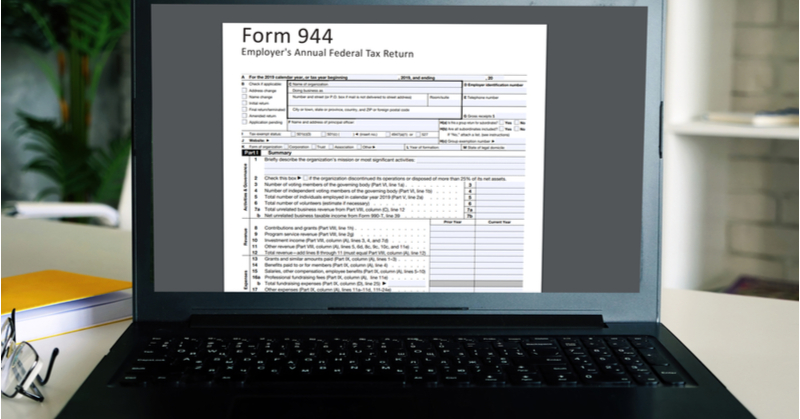As an accountant and trusted advisor, you know the oh-so many payroll forms that exist for employers. But, how much do your clients really know about all these forms? To keep your clients in the loop, give them a rundown of the most common payroll forms they absolutely need to know about.
What payroll forms should your clients know about?
From collecting forms from employees to filing payroll forms each quarter or year, there are a ton of forms to keep up with. To ensure your clients know which forms to file (or what information to gather for you to file the forms on their behalf), give your clients the scoop on these 11 payroll forms.
Payroll Forms to File
Payroll forms can vary from client to client, depending on location and (in some cases) the business’s size. You or your client must file many of these forms when submitting tax payments to the IRS.
To help your clients understand their payroll form responsibilities, give them an overview of the following forms (and be sure to let clients know which ones you are handling):
Federal forms
- Form 941
- Form 944
- Form 940
- Form W-2
- Form W-3
- Forms 1095-B and 1094-B
- Forms 1095-C and 1094-C
State and local forms
Federal Forms
There are a number of federal payroll forms your clients need to keep on their radar, including some that require copies to be sent to employees.
Form 941
Form 941, Employer’s Quarterly Federal Tax Return, is a quarterly form many employers need to file with the IRS to report federal income and FICA (Social Security and Medicare) taxes.
Clients must file Form 941 unless they filed a final return, are a seasonal employer, or employ household (e.g., nanny) or farm employees (e.g., Form 943). If a client must file Form 944, they do not need to file Form 941 (which we’ll get to more later).
Because Form 941 is a quarterly form, it has multiple due dates, including:
- April 30 for Quarter 1 (January 1 – March 31)
- July 31 for Quarter 2 (April 1 – June 30)
- October 31 for Quarter 3 (July 1 – September 30)
- January 31 for Quarter 4 (October 1 – December 31)
If your client must file Form 941, make sure they know their responsibilities and when it’s due. If you handle payroll taxes and filings for your client, let them know what information they need to provide (e.g., amount of FICA taxes) so you can file in a timely manner.
Form 944
Form 944, Employer’s Annual Tax Return, is like the annual version of Form 941 for smaller businesses. Certain businesses use Form 944 to report FICA and federal income taxes once a year instead of quarterly.
Clients can only file Form 944 if the IRS tells them to. Otherwise, they must file Form 941. Generally, a client whose annual liability for FICA and federal income taxes is $1,000 or less must file Form 944. And newer employers may also be able to use this form instead of Form 941.
Unlike Form 941, Form 944 only has one due date because it’s due annually: January 31.
If your client is unsure about which form to file, let them know the difference between Form 941 vs. Form 944 and make sure they are using the correct form if they are filing it themselves.
Form 940
As an employer, your clients must pay federal unemployment tax (aka FUTA tax) to the federal government. They must file Form 940, Employer's Annual Federal Unemployment (FUTA) Tax Return, to report the tax.
Let clients know they must file Form 940 if they:
- Paid wages of at least $1,500 to any employee during the standard calendar year OR
- Had an employee (temporary, part time, or full time) work anytime during 20 or more weeks
Form 940 is due each year by January 31. If the due date falls on a weekend or holiday, the form is due the following business day.
Form W-2
IRS Form W-2, as you are well aware, is a huge deal in the beginning of the year for employers. And if you want your clients to stay compliant, don’t keep them in the dark about it.
Form W-2, Wage and Tax Statement, records the amount each employee earned and the taxes your client withheld during the year. Clients must complete and file a W-2 form for each employee who worked for them during the year.
Form W-2 has multiple copies that go to various parties:
- Copy A: Social Security Administration (SSA)
- Copy B: Employee
- Copy C: Employee
- Copy D: Keep for your records
- Copy 1: State, city, or local tax department (if applicable)
- Copy 2: Employee
Forms W-2 are due to employees and the SSA by January 31 each year. If your client plans on handling Form W-2 on their own, make sure they’re aware of which copies go where and when it’s due.
Form W-3
Along with Forms W-2, employers must send Form W-3, Transmittal of Wage and Tax Statements. Form W-3 is simply a summary of W-2 information that includes employee wage and tax information.
Let clients know to send Form W-3 to the SSA with W-2 forms. And, be sure to tell them not to send Form W-3 to any employees. If you’re handling Forms W-2 and W-3 for your client, let them know in advance what information you need to complete and file the forms.
Like Form W-2, Form W-3 is also due by January 31 each year.
Health insurance forms
If your client offers health insurance to their employees, they may also need to file and distribute the following forms:
- 1095-B: Reports health coverage if your client offers an employer-sponsored self-insured plan
- 1094-B: Summarizes information from Form 1095-B
- 1095-C: Reports employer-provided health insurance offer and coverage if your client employs at least 50 full-time equivalent employees
- 1094-C: Summarizes information from Form 1095-C
If your client provides health insurance to employees, make sure they’re aware of the above forms.
State and local forms
In some cases, your client may need to file state and/or local payroll forms quarterly or annually.
State payroll forms may report:
- State unemployment tax
- State income tax
- State-specific taxes
Local payroll forms report:
- Local income tax
- Local-specific taxes
Make sure these types of payroll forms don’t slip your client’s mind if they’re handling filings themselves. Let your clients know which state or local forms they need to file or which forms you’re handling for them (if applicable).
If your clients are handling federal, state, and local payroll forms themselves, consider suggesting they use payroll software to simplify filings. Or, offer payroll services to clients and handle their payments and filings for an additional charge.
Craving more payroll forms information?
So many payroll forms, so little time, right? To help your clients keep track of the various forms and stay compliant, download a complete list of payroll forms and pass it on to your clients here (+ checklist!). Oh—and did we mention this in-depth guide is 100% free?!
.png?width=150&height=63&name=TWRlogo-regmark_blueblack%20(1).png)
.png)










Do you have questions about this article? Email us and let us know > info@woodard.com
Comments: